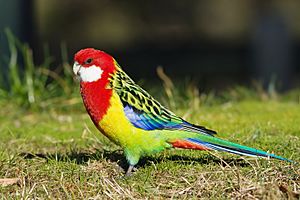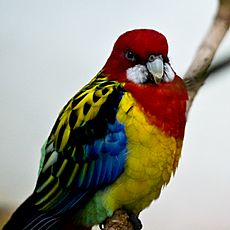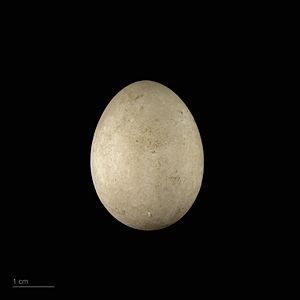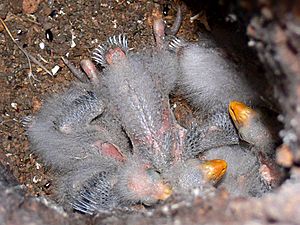Eastern rosella facts for kids
Quick facts for kids Eastern rosella |
|
|---|---|
 |
|
| P. e. diemenensis (male) | |
 |
|
| P. e. diemenensis (female) | |
| Conservation status | |
| Scientific classification | |
| Genus: |
Platycercus
|
| Species: |
eximius
|
The eastern rosella (Platycercus eximius) is a colorful rosella parrot. It is originally from the southeastern part of Australia and the island of Tasmania.
You can also find eastern rosellas in New Zealand. They live there in the wild, especially in the northern part of the North Island and near Dunedin in the South Island.
Contents
About the Eastern Rosella's Name
The eastern rosella was first named by a person called George Shaw in 1792. Sometimes, people thought it was a type of pale-headed rosella.
Scientists recognize three main types, or subspecies, of the eastern rosella:
- P. e. eximius: This type lives in Victoria and southern New South Wales. Its black back feathers have green edges.
- P. e. elecica: You can find this type in northeast New South Wales and southeast Queensland. Males have golden-yellow edges on their black back feathers, while females have greenish-yellow edges. This type is also known as the golden-mantled rosella.
- P. e. diemenensis: This type lives in eastern Tasmania. It has bigger white cheek patches and a darker red color on its head.
What Does an Eastern Rosella Look Like?

The eastern rosella is about 30 cm (12 in) long. It has a bright red head and white patches on its cheeks. Its beak is white, and its eyes are brown.
The top part of its chest is red, and the lower part is yellow. This yellow fades to a light green color on its belly. The feathers on its back and shoulders are black. They have yellow or green edges, which makes them look like scales. The color of these edges can be a bit different depending on the specific type and whether it's a male or female.
Its wings and outer tail feathers are bluish, and its main tail is dark green. The legs are grey. Female rosellas look similar to males but are not as brightly colored. Young rosellas are even duller than females.
Eastern rosellas mostly eat fruits, seeds, flowers, and insects.
Where Do Eastern Rosellas Live?
Eastern rosellas naturally live in eastern Australia and Tasmania. They like to live in places with light woods, open forests, gardens, and parks.
Eastern rosellas have also started living in the wild in New Zealand. They likely came from pet birds that escaped. By the 1970s, they were common in many parts of Auckland and Northland. They also spread to the Wellington-Hutt Valley area.
The first eastern rosellas arrived in New Zealand around 1910. Some birds were released near Otago Heads. They were meant to be pets but were not allowed into the country.
How Do Eastern Rosellas Have Babies?
Eastern rosellas usually lay eggs in spring. Sometimes, they will also breed in summer if needed. A female can lay between 2 and 9 eggs.
In the wild, they build their nests in hollows inside trees. These hollows are usually about 1 metre (3 ft) deep and 30 metres (98 ft) high up in a tree. A common sign that rosellas are ready to breed is when the male bird feeds the female.
Eastern Rosellas as Pets
Eastern rosellas are sometimes kept as pets because of their beautiful colors. They are smart birds that can learn to whistle many different tunes. Some can even learn to copy a few human words.
Rosellas can be good companion parrots. However, they need a lot of attention and many toys. This helps them feel connected and keeps their minds busy. These birds might not always fit in well as family pets. Even if they are raised by hand, they can sometimes still act a bit wild. They often do not like to be "petted" or "cuddled" and might bite if handled this way.
Many people think rosellas are happiest in large aviaries. This allows them to fly freely with less human interaction. Even with these challenges, many people enjoy having the eastern rosella as a beautiful pet bird.
- Simpson, K and Day, N,. Field Guide to the Birds of Australia 7th edition, 2004 ISBN: 0-670-04180-7
See also
 In Spanish: Perico multicolor para niños
In Spanish: Perico multicolor para niños






